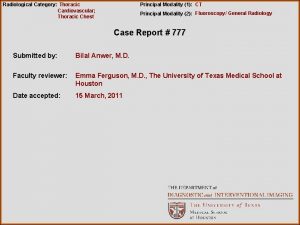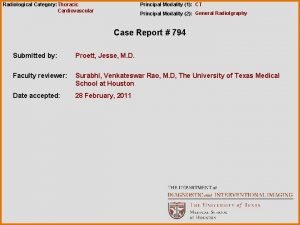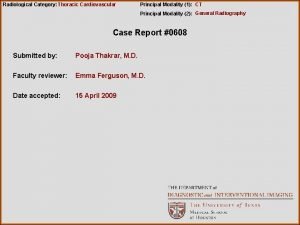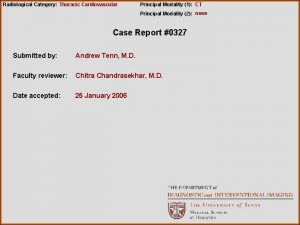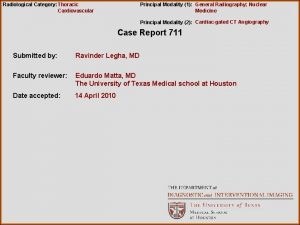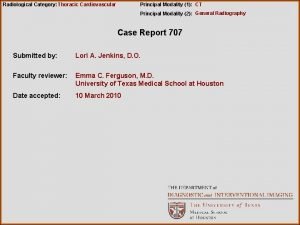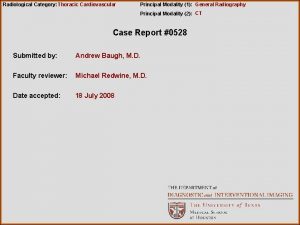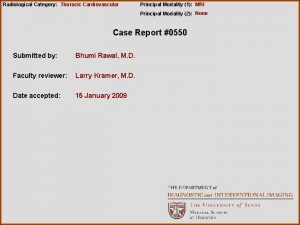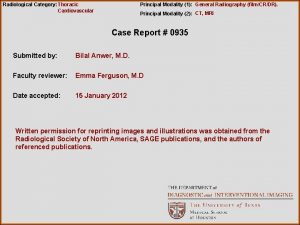Radiological Category Thoracic Cardiovascular Principal Modality 1 CT










- Slides: 10

Radiological Category: Thoracic Cardiovascular Principal Modality (1): CT Chest Angiogram Principal Modality (2): None Case Report #0540 Submitted by: Ravi Bodiwala, M. D. Faculty reviewer: Chitra Chandrasekhar, M. D. Date accepted: 09 January 2009

Case History 26 year old female with no significant past medical history presents with sudden onset of chest pain.

Radiological Presentations CT Angiogram at the level of aortic root

Test Your Diagnosis Which one of the following is your choice for the appropriate diagnosis? After your selection, go to next page. • Pulmonary embolus • Aortic dissection • Malignant anomalous right coronary artery

Radiological Presentations CT Angiogram at the level of aortic root

Findings and Differentials Findings: The right coronary artery has an anomalous origin from the left coronary cusp, and it courses between the aortic root and the right ventricular outflow tract. No pulmonary filling defect is seen. No intimal flap is visualized to indicate an aortic dissection. Differentials: • Malignant anomalous right coronary artery • Pulmonary embolus • Aortic dissection

Discussion Congenital coronary artery anomalies have an incidence of 1– 2% in patients undergoing coronary artery catheterization. The anomalies may be divided as follows: • Anomaly of coronary artery origin or course • Anomaly of structure • Anomaly of coronary artery termination The most common coronary anomaly is separate origins of the left anterior descending and the left circumflex arteries. This is followed by origin of the left circumflex artery from the right sinus of valsalva. The most common right coronary artery anomaly is, as described in this case, an anomalous origin from the left coronary cusp with the artery coursing between the aortic root and the right ventricular outflow tract (RVOT). Other less frequent right coronary artery anomalies include an artery originating from the pulmonary trunk, the distal ascending aorta, and the left main coronary artery. Approximately 20% of coronary artery anomalies are associated with potentially serious sequale, such as angina pectoris, myocardial infarction, syncope, cardiac arrhythmias, congestive heart failure, or sudden death [1].

Discussion An anomalous right coronary artery that originated from the left sinus of Valsalva and coursed between the aortic root and the RVOT was considered to have a benign outcome prior to 1982 [2]. However, more recent evidence indicates a high correlation between this anomaly and increased mortality. The incidence of sudden cardiac death is estimated between 25– 40%, causing some authors to refer to this coronary anomaly as “malignant” course of the right coronary artery. The exact mechanism is not clear; however, most patients become symptomatic during or immediately after exercise. Theories include a slitlike ostium, acute angulation at the coronary origin, and compression of the vessel between the aorta and the RVOT. Surgical management with coronary artery bypass grafting is the recommended treatment for patients with this abnormality. The main teaching point in this case is to look at the coronary arteries on all CT chest exams. In our case, the exam had been ordered as a CT pulmonary embolus protocol; nevertheless, the coronary arteries were well visualized, and allowed us to reach a diagnosis for this patient’s chest pain. Continued advancement in CT coronary angiography will most certainly increase the frequency with which radiologists see these abnormalities.

Diagnosis Malignant anomalous right coronary artery

References 1. Newatia A, Hines J. Aberrant left coronary artery. ACR Case in point. November 15, 2005. http: //caseinpoint. acr. org/edactic/QMachine. ASP? UID=1 KZ 0 ROFP&SESS=954269286 2. Hague C, Andrews G, Forster B. MDCT of a Malignant Anomalous Right Coronary Artery. AJR 2004; 182: 617 -18 3. Datta J, White CS, et al. Anomalous Coronary arteries in adults: Depiction at multi– detector row CT angiography. Radiology 2005; 235: 812 -818. 4. Jim MH, Siu CW, et al. Anomalous origin of the right coronary artery from the left coronary sinus is associated with early development of coronary artery disease. J Invasive Cardiol 2004; 16(9): 466 -468.
 Erate category 2
Erate category 2 Center for devices and radiological health
Center for devices and radiological health National radiological emergency preparedness conference
National radiological emergency preparedness conference Radiological dispersal device
Radiological dispersal device Tennessee division of radiological health
Tennessee division of radiological health Pacs modality workstation
Pacs modality workstation Short wave diathermy definition
Short wave diathermy definition Sensory vs somatic
Sensory vs somatic Sodality vs modality
Sodality vs modality Epistemic modality
Epistemic modality One to many relationship line
One to many relationship line











